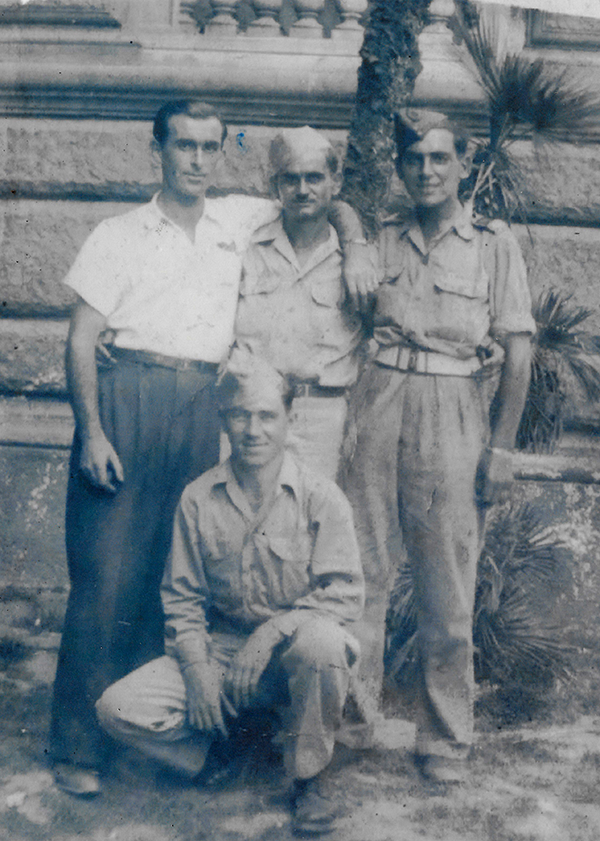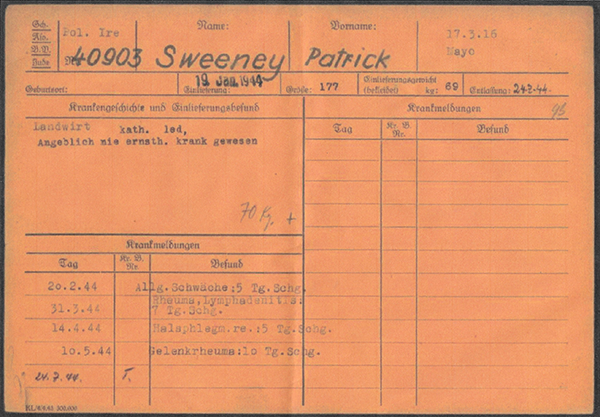FROM BALLYCROY TO BUCHENWALD—THE DOUBLE LIFE OF PATRICK SWEENEY
Published in Features, Issue 3 (May/June 2022), Volume 30How doubts about his identity led to an Irishman’s internment in France and his deportation to one of the Nazis’ most notorious concentration camps.
By Isadore Ryan
On 28 July 1941, the Irish legation to Vichy France received a two-page handwritten letter from an internment camp at Le Vernet, 55km south of Toulouse. The letter was from one Patrick Sweeney, who claimed to be a citizen of the Irish Free State, born on St Patrick’s Day 1915 in Dooriel West, Ballycroy, Co. Mayo. Sweeney, who explained that he had been interned in Le Vernet since December 1939 ‘for default of official papers’, was comparatively modest in his requests: if it proved impossible to arrange his release, he wanted the Irish authorities to organise his transfer to another camp or, failing that, some food parcels. Sweeney explained that he was ‘the only Irishman in the camp and seem abandon [sic] by all people. Most men here receive aid from some source.’ Remarkably, although he had been arrested almost two years before, this letter was the first inkling that the Irish legation had that Sweeney was being held in Le Vernet, which the French used as a place of detention for foreign ‘undesirables’.
ARREST IN SEPTEMBER 1939
Sweeney had been arrested in Paris on 3 September 1939, the very day France and the UK declared war on Nazi Germany. According to a police file dated 22 December 1940 and a version of his story which he provided to the Irish authorities, Sweeney had travelled to France from Jersey on 20 July 1939 for a holiday on a weekly return ticket that dispensed with the need for a passport. He decided to prolong his stay, however, travelling to Paris even though he had no ID. According to this police report, Sweeney was then arrested at his hotel and sentenced to three months in prison for stealing American Express travellers’ cheques to the value of US$2,000. Another internal police report dated 25 March 1941 has a slightly different version, mentioning that he had been imprisoned on accusations of stealing a £100 cheque from an American staying in the same hotel. Both reports mention that Sweeney was sent first to La Santé prison in Paris and then to Fresnes prison outside the city. Neither report mentions any trial—by this stage, normal judicial procedures had been suspended in France. The clampdown on foreigners became extremely rigorous after the declaration of war, with a circular from the minister of the interior in October 1939 ordering that ‘until further notice foreigners suspect from a national point of view or dangerous for public order should be taken to the border under escort or interned’.
Since he had no valid papers, Sweeney was taken from Fresnes to the transit camp set up for suspect foreigners at the Roland-Garros tennis grounds, and then on to Le Vernet in December 1939. A fellow detainee at both Roland-Garros and Le Vernet was the Hungarian Jew Arthur Koestler, who left a vivid description of his treatment in his book The scum of the earth.
SERVICE IN SPAIN?
Sweeney apparently shared something else with Koestler: they had both been in Spain during the Civil War. Koestler, a correspondent for the anti-Franco News Chronicle and a Communist activist, was imprisoned by Franco’s Nationalists in Seville in early 1937 before being released as part of a prisoner exchange.
Sweeney’s career in Spain is less clear. The succinct police report of December 1940 mentions that he ‘fought in Spain in the International Brigades from September 1936 to January 1939’ but also says that he was ‘not engaged in political activity’. The more expansive report of 25 March 1941 states that Sweeney had left London in July 1936 ‘at the invitation of his brother’ to fight for the Republican cause and was incorporated as a soldier 1st class in the 15th International Brigade. In a rapid ascension through the ranks, he was promoted to sergeant in October 1937, after the battle of Jarama, and captain in April 1938. Sweeney then took part in the battle of the Ebro, and after his capture in May 1938 was imprisoned in the fortress at Montjuic Castle. The Irishman was condemned to death on 4 June 1938, but during cleaning duties managed to grab hold of a Nationalist officer’s uniform to escape, hiding in the countryside for two months before crossing into France and making his way to Paris.
LE VERNET
Le Vernet was a miserable place. In Arthur Koestler’s words, the camp ‘was notoriously the worst in France … as regards food, accommodation and hygiene, Vernet was even below the level of Nazi concentration camps’. Thanks to influential friends in London, Koestler was released from Le Vernet in January 1940. By contrast, Patrick Sweeney, who had no such connections, was to languish in Le Vernet for three long years—before facing other ordeals.
Sweeney made several attempts to have himself released and repatriated. He even asked the British consul in Marseilles to be incorporated into the British army. In November 1940 he tried his luck with the American consul general in Marseilles. In the same month, under the name of John Genty, the authorities in Le Vernet approached the Irish legation on his behalf—but without papers to prove his identity all his efforts were in vain.

Above: Patrick Sweeney (left) in Naples shortly after his liberation from German custody in April 1945.
In between petitioning various authorities (and confusing them by using different names, nationalities and even dates of birth), Sweeney was put to work as a medical orderly at the camp hospital, a position that allowed him occasionally to go on supervised trips outside the camp, even as far as Toulouse, until suspicions that he was planning to escape caused him to be stripped of this job.
IRISH AUTHORITIES TURNED A DEAF EAR
While the Vichy authorities had no objection to Sweeney’s repatriation, the Irish turned a deaf ear to his pleas for help. Starting with the July 1941 letter, Sweeney wrote a barrage of letters to the legation, none of which received a reply. In none did he mention either that he had fought in Spain or that he had been imprisoned in Paris for theft (in one he slyly claims that ‘I have never been in trouble in Ireland’). He was finally invited to fill out a ‘declaration of nationality’ form in March 1942, in which he explained that he had left Ireland in 1934 and found work as a bricklayer in London before his fateful 1939 trip to Paris. Alas, on 22 June 1942 the legation wrote a four-line letter to Sweeney to inform him that it ‘cannot intervene on your behalf on the grounds that you are an Irish citizen’.
Behind the scenes, however, Irish officials were making enquiries as to who Patrick Sweeney really was. One was made to Jack Brent, secretary of the International Brigades Association, who merely replied that he had learned from an Englishman also interned at Le Vernet that an Irishman called Ginty (not Genty) was in the camp. Sweeney’s family in Ballycroy said that the only news that they had received was a letter from him ‘stating that he was belonging to the [British] Army and was just then in hospital in France’. On the strength of this testimony, the legation sent another succinct letter to Sweeney in November 1942, stating that the Irish Department of External Affairs (DEA) ‘is not prepared to authorize any action by the Legation’ because he had been a member of the British army and his family could not support him.
Finally, in January 1943, unable to find confirmation that Sweeney had indeed been in the British army and on the strength of his birth certificate, the DEA reluctantly decided that it had ‘no alternative but to authorize the issue of a passport to him’. In reply, Seán Murphy, the Irish minister to Vichy, recalled that Sweeney had indeed knocked on the legation’s door back in August 1939 seeking repatriation and armed with his story of having arrived in France from Jersey without a passport.
HANDED OVER TO THE GERMANS
While Irish officials dithered, however, their Nazi equivalents did not. When the Irish legation finally got around to sending a letter to Sweeney in Le Vernet in spring 1943 to inform him that he was to be granted an Irish passport, it was returned to sender with the note ‘gone away’. From further enquiries, it emerged that the French had handed Sweeney over to the Germans on 8 January 1943.
A few months earlier, Sweeney had further blotted his copybook and been sent to prison for eight days for stealing another internee’s shoes and trying to sell them. The Vichy ministry of the interior refused to explain to the Irish legation the reasons for this hand-over, but the French were surely eager to have one less mouth to feed and the Germans more than willing to deal with somebody whom the French records claimed was a veteran of the International Brigades.
In July 1943 the Irish minister in Berlin, Con Cremin, wrote that a German officer had informed him that ‘Sweeney had volunteered for work in Germany and that they would probably send him there for that purpose’. That was far from the truth. Sweeney next turns up at the start of 1944 in the files of Royallieu internment camp, about 80km north of Paris. Royallieu was used as a transit point for prisoners set to be deported to concentration camps in the Reich or further east, so it is unlikely that Sweeney spent more than a couple of months here. Thus the year after he was plucked from Le Vernet is shrouded in mystery, although one succinct record suggests that from Le Vernet he was sent again to Fresnes in the Paris suburbs.
BUCHENWALD
On 17 January 1944, Sweeney was deported from Royallieu to Buchenwald concentration camp along with 1,946 others. Crowded into cattle trucks, the deportees received just one bowl of soup during the two-and-a-half-day journey, with the train having to stop frequently because of repeated escape attempts. When he arrived in Germany, Sweeney was categorised as politisch Ire (Irish political prisoner). He was probably put to work by the Germans and malnourished. Yet for all Buchenwald’s deplorable reputation, the records show that Sweeney was repeatedly granted rest and medical treatment for ‘general feebleness’ and rheumatic pain.

Above: Patrick Sweeney’s Buchenwald infirmary card. Note the designation in the top left-hand corner—Pol. Ire (politisch Ire, Irish political prisoner). (ITS Archives)
His stay in Buchenwald was mercifully short, for in late July 1944 the Irishman was moved to a subcamp for civilian internees in Kreuzberg, near the city of Breslau (modern-day Wroclaw in Poland). The living quarters in Kreuzberg, a three-storied convent, were described by a Red Cross team that visited them in May 1944 as ‘satisfactory’ and the recreational facilities as ‘excellent’, with prisoners given the option of participating in work details (only a small minority did so). Kreuzberg was liberated by the Soviets in February 1945, by which time Sweeney had moved west to await liberation by the Americans a couple of months later. The putative brigadista lived and worked the rest of his life in England, for a time working on trawlers out of Fleetwood. Patrick Joseph Sweeney died in 1995 without ever apparently telling his entourage the details of his wartime adventures.
Isadore Ryan is a writer and financial editor based in Geneva.
Read More:
Further reading
A. Koestler, The scum of the earth (London, 1941).
I. Ryan, No way out—the Irish in wartime France (Cork, 2017).
















